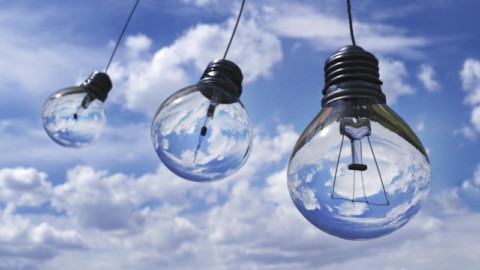by Dr Kari Dahlgren, Dr Jathan Sadowski, Associate Professor Yolande Strengers, Dr Larissa Nicholls and Professor Sarah Pink, Digital Energy Futures Project, Monash University
As we begin to adjust to the new normal brought about by the COVID-19 pandemic, we know things will not return exactly to the way they used to be. While we’re figuring out this new normal, we need to ask what aspects of our new lifestyles should stick around, and at what cost?
Nobody likes long video calls, for example, but the flexibility and speed of an e-commute may be difficult to give up.
What’s more, there also seem to be important environmental benefits that come with working from home.
The reduction in cars driving and planes flying has contributed to a significant drop in pollution around the world.
Considering the dire predictions of climate disasters, these reductions are necessary.
How do we capture and maintain these environmental benefits even as countries seek to reopen their economies?
“If emissions rebound, it is very difficult to see how they will be brought down in future,” said Fatih Birol, Executive Director of the International Energy Agency. But it’s not only a rebound in travel that we have to watch out for.
Many of the digital technologies that allow us to stay connected, productive, comfortable and entertained at home are also energy- intensive.
Replacing traffic jams with data centres, or highways with networks, will come with its own environmental cost. It’s important to remember that digital does not always mean more sustainable.
Staying at home
As part of a three-year Digital Energy Futures project, which is researching how current and future digital technology lifestyle trends are likely to impact energy demand, we developed six future scenarios that represent key industry predictions for the future, including one called The Stay at Home Life.
The Stay at Home Life scenario presents a future that places the home at the centre of nearly all our activities: work, study, leisure, entertainment and shopping – thus resulting in increased investment in, and reliance upon, digital technologies for new and existing services.
This version of our near-future life comes with significant energy implications, which are already apparent.
While overall electricity usage has remained relatively stable during the pandemic, it has shifted drastically to residential use, with estimates as high as a 40 per cent increase in household electricity use. This will lead to bill shock and energy hardship for many.
Should the lifestyle and technology trends envisioned in this scenario continue and accelerate, energy usage is likely to increase significantly, and change the timing of energy peaks.
Energy costs of smart home upgrades
The pandemic is already revealing that people invest in energy-intensive household goods when preparing to spend more time at home (if they can afford to do so). Many white goods have seen demand surge in recent months, particularly freezers.
Electronic and household goods stores JB Hi-Fi and the Good Guys have seen sales increase 20 per cent in the second half of the financial year.
In the US, in the midst of summer, personal swimming pools are in high-demand, one of the most energy-intensive luxuries available today.
As people upgrade and invest in home technologies, they are also likely to be ‘smart’ – often by default. Things like smart fridges, smart lights, digital voice assistants, and remote-controlled thermostats are often celebrated for their energy-saving capabilities.
They allow users to turn off appliances with apps, set automated routines – “Alexa, start my day” – and have the potential to be responsive to energy price signals and renewable energy sources.
However, these devices also allow for new entertainment, comfort and conveniences that potentially increase or shift energy demand in other areas, such as pre-cooling or -warming the home.
They are often used simultaneously, adding to an increasing suite of digital home devices.
In addition, while the devices themselves are usually more energy-efficient than their predecessors, the infrastructure required to make connected and smart things work, like the data centres filled with massive servers for storage and high-powered processors for computation, have created an energy pit.

While a reduction in air travel has had a positive impact on carbon dioxide emissions globally, some studies suggest that data centres may in fact contribute more to carbon dioxide emissions than the airline industry.
The energy costs of data
As we switch from in-person meetings, or even from phone calls to video teleconferencing, we are using significantly more data.
The more high-definition and seamless these videos become – let alone if we switch into virtual reality and other immersive technologies – the more our data and energy needs are likely to further increase in the future.
Data centres already use approximately 1-2 per cent of global electricity, and some estimates have even suggested they contribute more to carbon dioxide emissions than the airline industry.
And as The MIT Technology Review reports, “training a single (artificial intelligence) model can emit as much carbon as five cars in their lifetimes.”
Having an infinite supply of data at our disposal and a personal AI to run our household sounds fantastic, but at what hidden cost?
If the digital acceleration continues, without sufficient gains in efficiency, renewables and sustainable materials, the energy needs of our digital lives may soon undermine any potential environmental gains from staying at home– and worse.
This scenario is not inevitable
Whether or not the Stay at Home Life scenario will continue to accelerate and eventuate remains to be seen.
But one thing is already clear: it will likely continue to increase residential energy demand, and change the timing of current peaks.
Our future research will test industry scenarios like the Stay at Home Life with a diverse set of Australian households, to better understand how these visions might unfold in different ways.
From here, we will work with our industry partners to innovate so-called “demand management” programs, which seek to reduce or shift energy consumption in homes through technologies, campaigns and incentives.
Avoiding any significant environmental rebounds as we come out of COVID-19 restrictions will require ensuring we do not offset energy savings in one sector like transportation with energy usage in another like consumer electronics.
We cannot assume that a “smarter” world will fix our energy problems. But better planning and understanding of people’s changing digital lifestyles can help us imagine and realise more sustainable futures.



















